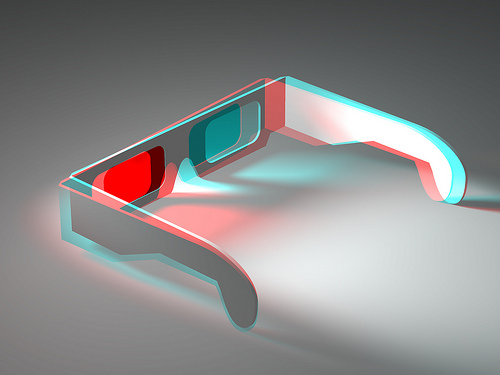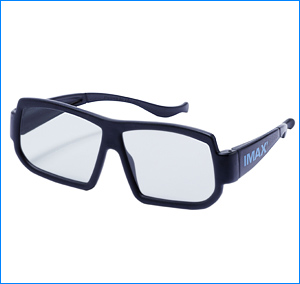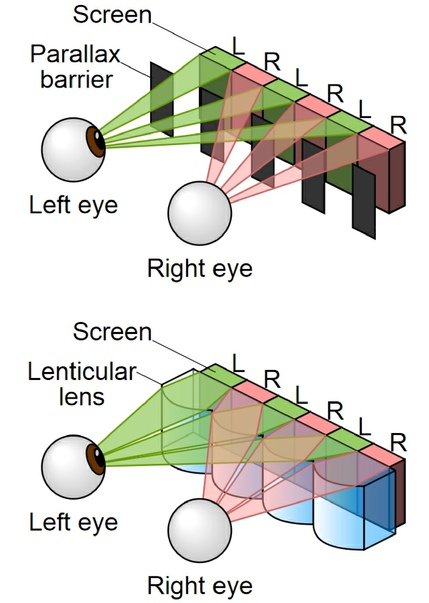About the technology of showing movies in 3D

3D cinemas have recently proliferated in large quantities. Not much lately 3d-TVs are lagging behind in their prevalence. However, what exactly is behind the marketing “3D” in each case is not always clear and obvious.
It is worth noting that it would be more correct to call this “stereo” movie, but the term “stereo” has long and firmly (simply, apparently, by right of precedence) entrenched in sound (in this respect, indicative, for example, the name of the magazine Stereo and Video "). Therefore, marketers had to use the term “3D”, which is associated with a three-dimensional image in one sense or another. In this case, the perception by the brain of the volume is understood by supplying an image to each of the eyes, slightly different from the image for the other eye, in the same way as the images received by the eyes in life.
Theory
So, to create a feeling of volume, you need to transfer your own picture to each of the eyes.
This can be done in the following ways:
- 1. Gate technology

Each eye has its own frame and these frames are interspersed. In order to separate the frames from one another you need points that will skip one frame and show another, synchronously with the display of these frames. These glasses always contain some kind of electronic filling, require batteries (and therefore their regular replacement), and, what is the most opposite, flicker. This technology is already quite old, back in the days of CRT NVidia produced video cards that doubled the frame rate and had special glasses connected to the video card, which closed (with the help of LCS - Liquid Crystal Shutter) one of the eyes in sync with the image. On the LCDs that replaced the LCD, this was no longer real, because the frequency of updating the first LCDs was much lower than the required 120 Hz. - 2. The second way is to combine a picture for both eyes simultaneously on the same screen and share it using filters in glasses. In this case, the filters on the glasses are passive, do not contain electronics, but divide the luminous flux based on some of the physical properties of this flux. You can divide in different ways:
- a) by color:

These are long-known blue-red (or some other colors with a non-intersecting spectrum) glasses. The easiest and most affordable way. The disadvantages of this method are that the colors are lost, moreover, after a long sitting in such colored glasses for some time after their removal, the eyes are seen in different colors, because they managed to adapt and adjust the “white balance” as they could. - b) by spectrum:

This is a somewhat complicated first method: all three colors are given to each eye, but in slightly different non-overlapping frequency ranges corresponding to each of the primary colors. - c) by polarization [5]. In this case, you can consider two subvariant:
- Linear polarization:

Linearly polarized light is an electromagnetic wave, in which the oscillations of the field vector lie in the same plane. In this case, each lens of glasses is a linear polarization filter that transmits light with polarization in the same plane and blocks light with polarization in the plane perpendicular to the first. In the intermediate planes, some part of the world is transmitted, depending on which of the main planes is closer to the polarization. Accordingly, you can draw a picture, where for the left eye there will be, for example, vertical polarization, and for the right one - horizontal (or vice versa). Then the glasses with the corresponding Polarians instead of glasses will filter the image for one eye from the image for another. There is a nuance: if the points are rotated 90 degrees, then the skipped pictures will change places. But under 45 degrees there will be no separation at all: both equally darkened pictures (with double “three-dimensional” objects) will pass through the glass. Thus, linear polarized glasses are very sensitive to head tilts. - Circular polarization:

For a light with such a polarization, the field intensity vector runs in a circle. It is very convenient that the eye has only two pieces, as well as the directions in which this vector can run (clockwise and counterclockwise). The filters for the corresponding points are circular polarics. No matter how you rotate, they will filter the light equally. Of course, you will not look at lying 3D, but it is quite possible to tilt your head to 30 degrees.
- Linear polarization:
- a) by color:
Practice
Now let's move on to practice, that is, to which of these technologies are now being used.
Cinema looks in cinemas, and cinemas are public and home. For them, the expediency of using different technologies is understandably different.
Public cinema technology
At the moment, two are more common: IMAX 3d [3] and RealD 3d [2]. Both use passive polarized glasses. Besides them, Xpan 3D [6] and Dolby 3D [4] technologies are also known, but they seem to be less common.
')
IMAX 3D

Aimax uses linear polarization with glasses, and the image is projected by two projectors onto one screen. The resulting image in my experience is very bright, saturated, the glasses almost do not darken the image, there is only one thing: sometimes the so-called crosstalk is seen, that is, the eye can see a kind of translucent image that is intended for the other eye. For my taste, a very unpleasant effect.
RealD 3D

For RealD 3D, the polarization is circular, but the glasses are darker, and the film is shown using a single projector, which shows frames for the left or right eye 144 times a second, and there is a synchronized filter in front of the projector lens, which gives appropriate polarization of light. In this sense, there is some kind of mix from the first and second type of technology, the separation of pictures by time is transferred from glasses (which are passive and, accordingly, cheap, which is critical for public cinemas) into an additional filter in front of the projector. This filter, by the way, reduces brightness even more, so RealD technology is very “dark”. From my own experience I can still say that there are any problems with colors, in theory there shouldn't be any, but there are. Not only are they dull, so also for some reason decreases the number of perceived shades of color. In addition, for some reason I still distinguish far fewer details in RealD-glasses than without them.
Xpand 3d

This is the only representative of the technology of the first type - active glasses, synchronized with the signal from the projector. I have not met in cinemas, but it is possible that somewhere here it is used, if anyone knows where, tell me, it is interesting to try.
Dolby 3D

Representative of technology type 2b according to the classification from the first part of the article. They say glasses for this technology are expensive, so they are made heavy enough to reduce the likelihood of theft. Again, I have not met, but I would like to try, even more than Xpan 3D.
Home theaters
Although, in principle, a home theater can also be based on a projector, but this is relatively rare, so we will only talk about televisions. Moreover, about their most widely spread type at the moment - about LCD TVs. The home theater can also be a computer with a monitor, but almost all modern monitors are also LCD and all the same technologies can be used there.
Basically there are two technologies that are bright representatives of the first and second types.
Shutter technology

Most manufacturers (for example, Samsung, Sony) equip TVs with 3D shutter technology that requires active glasses. Due to the limitations of LCDs (well, liquid crystals cannot switch between states quickly enough) for each displayed film frame there are four displayed frames: a frame for one eye, a dark frame, a frame for the second eye, and another dark frame. A dark frame is necessary, because hijacking an LCD pixel to black is faster than driving it to another intermediate state. Accordingly, in fact, the eye reaches 25% of the 2d brightness of the TV. Plus, the glasses are filtered. So the brightness of the picture is the disadvantage of this technology the number of times.
I already mentioned lack 2: glasses are twinkling. And flicker with a frequency not the highest, for example, 60 Hz. Those who sat on old CRT monitors will understand and shudder. Moreover, if this flickering on the film itself is not very noticeable (we watched TVs at 50Hz), then the flickering of the external light source filtered by the glasses already looks quite disgusting. Plus, there may still be an additional degrading factor, consisting in the fact that the flicker frequencies of the glasses may be close to the flickering frequencies of the source itself, but not coincide in phase.
Other disadvantages of active glasses: heavy, expensive, incompatible - each manufacturer has its own synchronization protocol with the TV.
For the sake of justice, I must say that most likely this technology will be developed and, possibly, has already developed. For example, you can raise the frequency and then the problem with flicker will not be so pronounced.
Polarization technology

Quite everything is different with TVs using passive polarization technology (such TVs are made, for example, by LG).
The essence of the technology is as follows: each line of the TV has a different filter, due to which all even lines have circular polarization in one direction, and odd ones in the other. If you watch 3d on such a TV without glasses, you will see a “comb”, that is, a mismatch between even and odd lines. The glasses simply filter the appropriate polarization for each eye. They are light, cheap and without batteries. Do not flicker . In addition, they are interchangeable with RealD glasses (and similar glasses from other manufacturers), so you can drag glasses out of the movie and watch TV in them, or, even better, take your glasses from the TV to the movies.
These were all pluses. Theoretically, the minuses of the technology are the following: 1080p is shown for each eye with 540 lines. True, the frame rate doubles, and on the same line for one eye it shows the even, then the odd line of content. In addition, for technological reasons, the shadow mask between the lines on such a TV is slightly wider than usual (for it is necessary to move somewhere from one filter to another).
In practice [1], the following becomes clear: since the content in the vertical coordinate for adjacent lines is almost identical, after the formation process in the brain of a three-dimensional picture, the absence of half of the lines is leveled and the perceived clarity of the picture is only slightly lower than in the 2d version.
The shadow mask is more than usual from a practical point of view on such an insignificant amount that it is not worth mentioning this.
Other technologies

Firstly, there is information that there are televisions that do not require glasses to view bulk content. Apparently, there is used a technology similar to the one that allows you to create cards with a sense of volume, that is, the image is divided vertically into strips, in front of which is a prism directing light from one strip to one eye, and from the next to the other. Obviously, in this case the range of places from which the volume will be observed is rather limited. However, this is not a significant limitation for small screens and this technology is used in one of the LG phones and in a handheld game console from Nintendo.
Secondly, you can make two small screens and hang them directly in front of your eyes, you get a helmet (or glasses) of virtual reality. Together in this way, the movie also did not look.
Thirdly, I got the idea that it is possible to adapt a technology similar to Dolby 3D for a TV set, that is, to make 6 pixels for a pixel with different non-intersecting spectra. Most likely it will be expensive in terms of production of both TV and glasses, but what if someone has already done or will do?
"Literature"
Source: https://habr.com/ru/post/154749/
All Articles